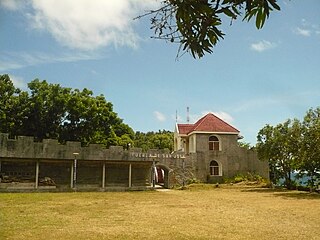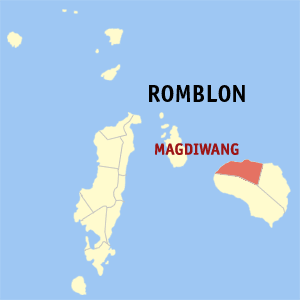
The Philippines is an archipelago that comprises 7,641 islands with a total land area of 300,000 square kilometers (115,831 sq mi). It is the world's 5th largest island country. The eleven largest islands contain 95% of the total land area. The largest of these islands is Luzon at about 105,000 square kilometers (40,541 sq mi). The next largest island is Mindanao at about 95,000 square kilometers (36,680 sq mi). The archipelago is around 800 kilometers (500 mi) from the Asian mainland and is located between Taiwan and Borneo.

Luzon is the largest and most populous island in the Philippines. It is ranked 15th largest in the world by land area. Located in the northern portion of the archipelago, it is the economic and political center of the nation, being home to the country's capital city, Manila, as well as Quezon City, the country's most populous city. With a population of 53 million as of 2015, it contains 52.5% of the country's total population and is the fourth most populous island in the world.

Romblon is an archipelagic province of the Philippines located in the Mimaropa region. Its main islands include Tablas, the largest, which covers nine municipalities, Sibuyan with its three towns, as well as the smaller island municipalities of Corcuera, Banton, Concepcion, San Jose, and Romblon, the provincial capital. The province lies south of Marinduque and Quezon, east of Oriental Mindoro, north of Aklan and Capiz, and west of Masbate. According to the 2015 census, it has a total population of 292,781.

Mimaropa, formally known as the Southwestern Tagalog Region, is an administrative region in the Philippines. It was also formerly designated as Region IV-B until 2016. It is one of two regions in the country having no land border with another region. The name is an acronym combination of its constituent provinces: Mindoro, Marinduque, Romblon and Palawan.

Tablas is the largest of the islands that comprise the province of Romblon in the Philippines. The name of the island was of Spanish origin. Before the colonization of the Philippines, Tablas was known as the Island of Osigan. At the time of contact with Westerners, Osigan had a population of two hundred and fifty people living in small villages. Wax was produced in this island.

Sibuyan is a crescent-shaped island, the second largest in an archipelago comprising Romblon Province, Philippines. Located in the namesake Sibuyan Sea, it has an area of 445 square kilometres (172 sq mi). The island has two prominent peaks, Mount Guiting-Guiting with a height of 2,058 metres (6,752 ft) and Mount Nailog with a height of 789 metres (2,589 ft). The people speak the Sibuyanon dialect of Romblomanon, a Visayan language.

Mount Guiting-Guiting or G2 is the highest mountain in the province of Romblon in the Philippines, with an elevation of 6,752 ft (2,058 m) above sea level. Its ranked 73rd-highest peak of an island on Earth. Located at the heart of Sibuyan Island and dominates the entire island. Guiting-Guiting, in the local Romblomanon dialect, means "jagged". The mountain is one of the focal points of Sibuyan's declaration as a biodiversity haven. The entire island has been compared numerous times with the biodiversity endemism rate of the Galapagos islands.

San Fernando, officially the Municipality of San Fernando, is a 4th class municipality in the province of Romblon, Philippines. According to the 2015 census, it has a population of 23,271 people.

Banton, officially the Municipality of Banton,, is a fifth-class municipality in the province of Romblon, Philippines. According to the 2015 census, it has a population of 5,536 people.

Cajidiocan, officially the Municipality of Cajidiocan, is a 4th class municipality in the province of Romblon, Philippines. According to the 2015 census, it has a population of 21,861 people. The municipality is located on Sibuyan Island, which has been dubbed as the "Galapagos of Asia" due to its pristine natural environment and high endemism rate for flora and fauna.

Corcuera, officially the Municipality of Corcuera, is a 5th class municipality in the province of Romblon, Philippines. According to the 2015 census, it has a population of 10,283 people.

Magdiwang, officially the Municipality of Magdiwang, is a 5th class municipality in the province of Romblon, Philippines. According to the 2015 census, it has a population of 14,142 people.

Romblon, officially the Municipality of Romblon, is a 3rd class municipality and capital of the province of Romblon, Philippines. According to the 2015 census, it has a population of 38,758 people.

Nepenthes sibuyanensis is a tropical pitcher plant endemic to Sibuyan Island in the Philippines, after which it is named.

Verde Island Passage is a strait that separates the islands of Luzon and Mindoro, connecting the South China Sea with the Tayabas Bay and the Sibuyan Sea beyond. It is one of the busiest sea lanes in the Philippines because it is the main shipping route between the Port of Manila and the Visayas and Mindanao in the south. Also, many ferries navigate the waters, connecting the surrounding provinces of Batangas, Marinduque, Occidental Mindoro, Oriental Mindoro and Romblon. The 1.14 million hectare passage is extremely rich in marine biodiversity, the richest area in the entire Coral Triangle. It has been called "Center of the Center of Marine Shorefish Biodiversity". Various conservation groups have been pushing for its nomination as a UNESCO World Heritage Site.

The National Council of Churches in the Philippines is a fellowship of ten Protestant and non Roman Catholic Churches in the Philippines denominations, and ten service-oriented organizations in the Philippines. A member of the World Council of Churches and the Christian Conference of Asia, the NCCP represents close to twelve million Protestant adherents. Advocacy for environmental protection and against large-scale mining are part of its core mission. Christian organizations other than churches may be received as associate members.

Rodne Galicha y Rodiño is a Filipino environmentalist and human rights activist currently involved in climate justice, biodiversity conservation and natural resources conflict management. He is the author of a pocket-sized book on emerging environment issues: We Are Nature. On 5 December 2013, he received the 2013 Hero for the Environment national individual award from the Center for Environmental Concerns in collaboration with the Department of Environment and Natural Resources of the Republic of the Philippines. He was Philippine Manager for The Climate Reality Project and currently doing his voluntary work for ecological and cultural organization called Bayay Sibuyanon in his home-island of Sibuyan. In 2018, the Philippine Tatler included him in the Generation T list as one of the 50 brightest connectors, creative visionaries, influential innovators and disruptive talents in the Philippines. He is also one of the recipients of the 2018 The Outstanding Young Men and Women (TOYM) of the Philippines. Stepping-up climate and environmental action within faith communities, he is lead convenor of Living Laudato Si movement in the Philippines. He co-founded Climate Action for Sustainability Initiative (KASALI).

The Batangas International Port or locally known as the Batangas Pier, is a seaport in Barangay Santa Clara, Batangas City primarily serving the Calabarzon region of the Philippines. The seaport covers an area of about 150 hectares.

The Greater Negros–Panay rain forests ecoregion covers the central Visayan Islands in the Philippines, including the islands of Panay, Negros, Cebu, Masbate, Sibuyan, Ticao, Guimaras, Romblon, Tablas, Siquijor, and Bohol, but excludes Leyte and Samar. During the last ice age, these were all on the same island. The lack of a land bridge to Asia during the ice age kept most Asian megafauna, including elephants and tigers, from reaching the Philippines and the Visayan Islands, which hosts many unique and endemic species with some exclusive only to an island.

The Guyangan Cave System is a group of caves located in the island municipality of Banton, Romblon in the Philippines. It is located in Guyangan Hill, a limestone formation situated in barangays Togbongan and Toctoc, and consists of seven caves spread in an 85.3 hectare area of forest land.


















